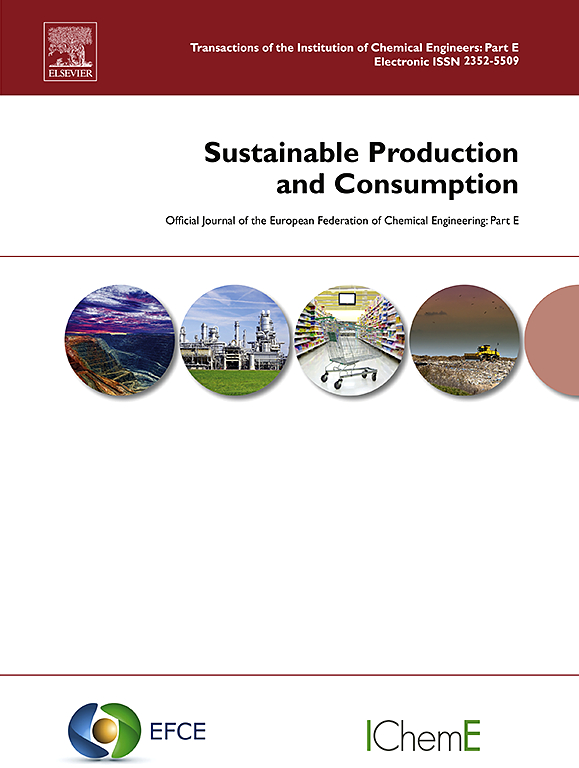A comparative life cycle assessment of novel technologies: Extraction of essential oils from rosemary leaves
IF 10.9
1区 环境科学与生态学
Q1 ENVIRONMENTAL STUDIES
引用次数: 0
Abstract
Prior to industrial-scale implementation, a multidimensional evaluation of extraction efficiency, environmental impacts, and cost-effectiveness is critical for identifying optimal extraction techniques. This study systematically compared four rosemary essential oil extraction methods—deep eutectic solvent-assisted hydrodistillation (DES-HD), ultrasound-assisted hydrodistillation (UA-HD), cellulase-assisted hydrodistillation (CA-HD), and conventional hydrodistillation (HD)—by integrating yield analysis, life cycle assessment (LCA), and economic feasibility. DES-HD achieved the highest yield (0.78 %), then followed by UA-HD, CA-HD and HD. The antioxidant activity of DES-HD essential oil was 1.5 times that of HD, and it was attributed to its elevated total monoterpene/oxygenated monoterpene content (91.37 % for DES-HD vs. 81.40 % for HD), which also enhanced its antimicrobial performance. However, LCA revealed DES-HD as the least sustainable option due to energy-intensive DES synthesis and significant toxicity impacts, challenging its designation as a “green solvent.” To offset its ecological footprint, DES-HD would require a yield exceeding 1.78× that of UA-HD. In contrast, UA-HD emerged as the most sustainable and economically viable method, with the lowest standardized environmental impact and industrial energy consumption (2.07 kWh/kg), minimal selling price ($17.51/kg), and shortest payback period (4.46 years). Sensitivity analysis identified electricity consumption and solvent production were the dominant factors causing environmental burden, which can be mitigated by improving energy efficiency and solvent recovery, reducing extraction time, and attempting low-carbon transition of electricity generation mix. These findings highlight UA-HD as the optimal technique for rosemary essential oil production, while cautioning against the uncritical adoption of “green” solvents without holistic environmental and economic validation. The study provides a framework for advancing sustainable essential oil extraction by aligning solvent selection with rigorous multidisciplinary evaluation.

新技术的生命周期比较评估:从迷迭香叶中提取精油
在工业化规模实施之前,对萃取效率、环境影响和成本效益进行多维度评估对于确定最佳萃取技术至关重要。本研究通过综合产量分析、生命周期评估(LCA)和经济可行性,系统比较了四种迷迭香精油萃取方法--深层共晶溶剂辅助水蒸馏法(DES-HD)、超声波辅助水蒸馏法(UA-HD)、纤维素酶辅助水蒸馏法(CA-HD)和传统水蒸馏法(HD)。DES-HD的收率最高(0.78%),其次是UA-HD、CA-HD和HD。DES-HD精油的抗氧化活性是HD的1.5倍,这归因于其总单萜/含氧单萜含量的提高(DES-HD为91.37%,HD为81.40%),这也增强了其抗菌性能。然而,生命周期评估显示,DES-HD 是可持续发展性最差的选择,原因是 DES 的合成过程耗费大量能源,而且会产生严重的毒性影响,这对其 "绿色溶剂 "的称号提出了挑战。要抵消其生态足迹,DES-HD 的产量需要超过 UA-HD 的 1.78 倍。相比之下,UA-HD 是最具可持续性和经济可行性的方法,其标准环境影响和工业能耗最低(2.07 千瓦时/千克),售价最低(17.51 美元/千克),投资回收期最短(4.46 年)。敏感性分析表明,电力消耗和溶剂生产是造成环境负担的主要因素,可通过提高能源效率和溶剂回收、缩短萃取时间以及尝试发电组合的低碳转型来减轻环境负担。这些研究结果突出表明,UA-HD 是迷迭香精油生产的最佳技术,同时提醒人们不要在没有进行全面的环境和经济验证的情况下,不加批判地采用 "绿色 "溶剂。这项研究通过将溶剂选择与严格的多学科评估相结合,为推进可持续精油萃取提供了一个框架。
本文章由计算机程序翻译,如有差异,请以英文原文为准。
求助全文
约1分钟内获得全文
求助全文
来源期刊

Sustainable Production and Consumption
Environmental Science-Environmental Engineering
CiteScore
17.40
自引率
7.40%
发文量
389
审稿时长
13 days
期刊介绍:
Sustainable production and consumption refers to the production and utilization of goods and services in a way that benefits society, is economically viable, and has minimal environmental impact throughout its entire lifespan. Our journal is dedicated to publishing top-notch interdisciplinary research and practical studies in this emerging field. We take a distinctive approach by examining the interplay between technology, consumption patterns, and policy to identify sustainable solutions for both production and consumption systems.
 求助内容:
求助内容: 应助结果提醒方式:
应助结果提醒方式:


